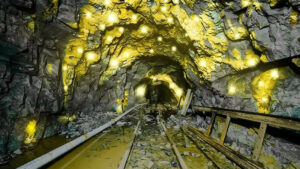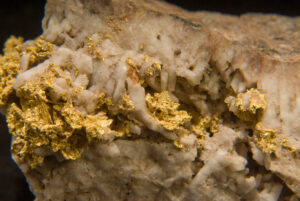
Entrance to the abandoned gold mine Colorado Mountains near Ouray
Africa plays a pivotal role in global gold production, contributing approximately 25% of the world’s total output. In 2022, West Africa alone produced around 435,150 kilograms of gold, marking an increase from the previous year . This substantial production underscores the continent’s rich mineral reserves and its significant position in the global mining industry.
South Africa, historically renowned for its vast gold deposits, has experienced fluctuations in production levels. In 2022, the country’s gold production was reported at 88,883 kilograms, a decline from 107,890 kilograms in 2021 . This downward trend highlights the challenges faced by the South African gold mining sector, including aging infrastructure and deeper, more costly mining operations.
The economic impact of gold mining extends beyond production figures. Events like the Mining Indaba conference significantly boost local economies. In 2022, the Mining Indaba contributed R156 million to South Africa’s GDP, with 73% of this from international sources, and generated 214 full-time annual job equivalents . Such events not only highlight the importance of the mining sector but also emphasize its role in fostering economic growth and employment opportunities within the region.
Ghana: Africa’s Gold Powerhouse
Ghana has solidified its position as Africa’s leading gold producer, surpassing South Africa in recent years. In 2021, Ghana’s gold mine production reached approximately 117.6 metric tons, reflecting a significant increase from 87.6 metric tons in 2011. This growth underscores the country’s robust mining sector and its pivotal role in the national economy.
The prominence of gold mining in Ghana is further highlighted by its substantial contribution to the nation’s export revenue. In 2024, gold exports amounted to $11.6 billion, accounting for 57% of the country’s total export earnings. This substantial financial influx underscores the critical role of gold mining in Ghana’s economic landscape.
Several major mining companies operate within Ghana, bolstering its status as a gold powerhouse. Notable entities include AngloGold Ashanti, with operations in Obuasi and Iduapriem; Gold Fields Ghana Ltd., managing the Tarkwa and Damang mines; and Newmont Ghana Gold Ltd., operating in Kenyasi. These companies have been instrumental in advancing Ghana’s mining industry, contributing to both local employment and technological advancements in mining practices.
South Africa: A Former Giant in Gold Production
South Africa once dominated global gold production, reaching a peak output of approximately 1,000 metric tons in 1970. However, by 2024, production had declined to 100 metric tons, reflecting a significant decrease over the decades. This decline is attributed to factors such as the depletion of easily accessible reserves and the increasing depth of mining operations, which pose technical and safety challenges.
Despite these challenges, South Africa remains home to some of the world’s deepest and most significant gold mines. The Mponeng Gold Mine, located southwest of Johannesburg, extends over 4 kilometers below the surface, making it the deepest mine globally. Similarly, the Kusasalethu Gold Mine reaches depths of approximately 3.38 kilometers. These ultra-deep mining operations highlight the country’s enduring role in the global gold mining industry.
Major mining companies continue to operate in South Africa, contributing to the nation’s gold production. Harmony Gold, for instance, reported a gold production of 790,000 to 805,000 ounces for the six months ending December 2024. However, the industry faces ongoing challenges, including declining production and the need for technological advancements to access deeper reserves safely and efficiently.
Sudan: A Rising Gold Producer
Sudan has emerged as a significant player in Africa’s gold mining industry, achieving record production levels in recent years. In 2022, the country produced approximately 109 tons of gold, surpassing its previous peak of 107 tons in 2017. This growth positions Sudan among the top gold producers on the continent.
A substantial portion of Sudan’s gold output originates from artisanal and small-scale mining (ASM), involving an estimated 1 to 1.5 million individuals. These mining sites have evolved into significant migration hubs, attracting thousands from Sudan and neighboring countries seeking economic opportunities. However, the prevalence of ASM presents challenges, including environmental degradation and health risks associated with rudimentary extraction methods.
Recognizing the potential of the gold sector to bolster the national economy, the Sudanese government has initiated efforts to formalize and regulate the industry. Strategies include enhancing oversight of production companies and implementing policies to curb illegal mining activities. These measures aim to maximize revenue from gold exports and ensure sustainable development within the sector.
Mali: A Mining-Driven Economy
Gold mining is the backbone of Mali’s economy, contributing over 80% of the country’s total exports in 2023. This sector not only fuels national revenue but also provides livelihoods for more than two million people, underscoring its socio-economic significance.
The nation hosts some of West Africa’s largest mining projects. Notably, B2Gold’s Fekola Mine stands as a world-class operation, ranking among Africa’s largest gold mines. Additionally, Barrick Gold operates the Loulo-Gounkoto mining complex, a significant contributor to Mali’s gold output.
Recent policy changes and political instability have posed challenges to the mining sector. In 2023, Mali introduced a new mining code aiming to increase the government’s share in mining revenues, leading to disputes with major companies. For instance, Barrick Gold faced operational suspensions following disagreements over the new regulations. Despite these hurdles, Mali’s gold production remains substantial, reflecting the sector’s resilience and enduring importance to the nation’s economy.
Burkina Faso: A Fast-Growing Gold Hub
Burkina Faso has rapidly emerged as a significant player in Africa’s gold mining industry, ascending to become the continent’s fifth-largest gold producer. In 2021, the country’s gold output reached 67 tons, marking a 10% increase from the previous year and generating approximately US$544 million in state revenues. This surge in production underscores the nation’s rich mineral reserves and its appeal to foreign investors.
The mining sector in Burkina Faso is dominated by prominent companies such as IAMGOLD and Endeavour Mining. These corporations have been instrumental in developing large-scale mining operations, contributing significantly to the country’s economic growth. However, the sector faces substantial challenges due to escalating security concerns. In recent years, the rise in militant activities has led to increased threats against mining operations, resulting in temporary shutdowns and heightened operational risks.
To address these challenges, the Burkina Faso government has implemented measures aimed at enhancing security for mining companies. These efforts are crucial in maintaining investor confidence and ensuring the continued growth of the mining sector, which remains a cornerstone of the nation’s economy.
Africa’s gold mining industry remains essential to global supply, with its vast reserves supporting both local economies and international markets. As production expands in key regions, ongoing investments in infrastructure and technology are shaping the future of the sector. Addressing regulatory frameworks and security risks will be critical in sustaining growth and maintaining investor confidence.
The demand for gold continues to drive exploration efforts, unlocking new deposits and increasing output across the continent. With mining operations adapting to evolving challenges, Africa is set to strengthen its position in the global gold market. The industry’s long-term success will depend on balancing resource extraction with economic stability and sustainable practices.



